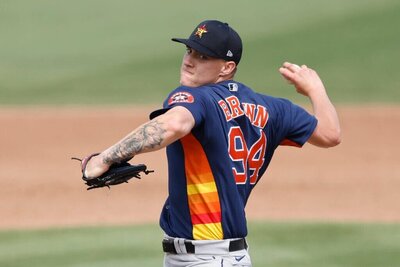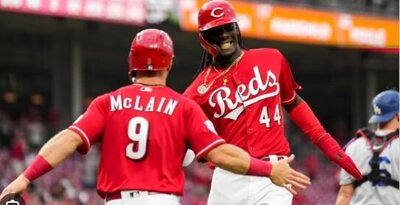Carlos Santana- Carlos Santana looks like a different player since returning from a seven (7) day stint on the Disabled List for a concussion, and fantasy owners could not be more pleased. It seems the regression that so many, including this writer, predicted for Santana during his early season slump has finally set in. There is little doubt that we will see a career worst season for Santana when it comes to batting average in 2014, but his .209 BABIP is still depressed and should continue to regress as the season moves along. An incredibly low 14.4% Line Drive Rate will hinder that positive regression somewhat, but he still likely to add another 20-30 points in average between now and season's end. The other positive is, that despite his abysmal beginning of the season with batting average, Santana has been able to consistently hit for similar power to what we are used to. His .167 ISO is in line with his three year averages, and it could even increase a bit as Santana is hitting more fly balls (40%) and has a higher HR/FB Rate (14.1%) than either of the past two seasons. Between his solid power, elite plate patience (18.4% BB Rate) and improving average, Santana is a solid option moving forward especially given his multi-position eligibility in most leagues. I'm buying Santana if he is still available for purchase.
Josh Hamilton- Josh Hamilton returned from the Disabled List and immediately caught fire. While we are dealing with a small sample size from Hamilton in only 82 plate appearances, it is worth noting some issues that may lead to some ups and downs over the course of the next several months. The first issue that we must deal with is Hamilton's wildly inflated BABIP. At .429, his single's percentage has nowhere to go but down. Even if he can sustain his 25.4% Line Drive Rate, it is just not realistic for Hamilton to carry anywhere near that high of a BABIP. As such, his .329 batting average will be subject to negative regression over the coming months. Anyone who owns Hamilton though should not be shocked by this turn of events especially considering his 25% K Rate, which is supported by his three year averages. The more concerning trend might be with Hamilton's power. Specifically, Hamilton has only a 28.8% Fly Ball Rate to this point of the season. This number would be a career low, and it does not bode well for owner's relying on Hamilton for power. If the ball isn't in the air, it can't get out of the park. I'm not recommending a sell-position on Hamilton yet, but I am certainly advising owners to keep their eyes on that Fly Ball Rate. Hopefully, as the sample size plays out over the next two to four weeks, we will see that rate normalize and expectations for a 15-20 home run season can be solidified. However, there is enough smoke here (increased BABIP, low Fly Ball Rate, High Ground Ball Rate, High K Rate) that there might be fire. Be cautious, you can live with the dip in average and strikeouts as long as that ball is leaving the park.
Billy Butler- I wonder if there is something in the water in Kansas City that causes their home grown power hitters to pound the ball into the ground. It certainly seems that way between Billy Butler and Eric Hosmer. I have spent several pieces on advising owners to avoid and/or release Hosmer. I thought I would touch on Butler, who sadly does not offer much more than Hosmer to the fantasy community. Butler has always been prone towards high Ground Ball Rates, but his last two seasons have been devastatingly high for a player who makes his living as a middle of the order run producer. At 53.1% and 52.6% Ground Ball Rates in 2013 and 2014, it has hard to recommend Butler as a starting first baseman/corner infielder/utility option. As his Ground Ball Rates have risen over the course of the last three seasons, his Fly Ball Rates have faded (28.8% in 2012, 26.4% in 2013 and 25.4% in 2014). This season has provided and even more dreary result than in years past as Butler's HR/FB is at a career low of 3.8%. While this HR/FB seems like a statistical outlier primed for regression over the next several months, the question remains: even if Butler ends up hitting another 8-9 home runs this season, is it enough to justify his spot on a fantasy roster? The roster around him is not efficient enough to provide him with opportunities to add to your counting stats and his batting average while slightly low at .267 will not positively regress all that much. Butler, much like Hosmer, offers owners a mostly empty .265-.285 batting average with little else. Butler has had a hot June slashing .326/.385/.500. I would start selling Butler while he is hot. Even in the midst of this streak, he is hitting 47.6% of his balls on the ground. Sell, while the selling is good.
Max Scherzer- The reigning AL Cy Young award winner has had his ups and downs through his first 98.1 innings in 2014. Tuesday night was one of the downs as he allowed 8 earned runs over 4 innings pitched while striking out 5 and walking 1. Scherzer continues to be one of the elite strikeout artists in the game although he is showing some wear and tear this season. This is not unusual consider the amount of innings that he has thrown over the last three seasons, but it is worth noting that his 27.1% K Rate, while elite, is a three year low for Scherzer. It is also worth noting that his BB Rate is up slightly from 2013 to 7.1%. These should not be huge issues for the remainder of the season, but as Scherzer is approaching his 30th birthday, it is worth noting the continuing erosion in his skill set. Owners should be cautious with Scherzer moving forward. His fastball velocity has decreased each of the last three seasons (94.2 MPH in 2012, 93.3 MPH in 2013 and 92.3 MPH in 2014). Scherzer is still an elite option for the remainder of this season, but he is following a similar pattern to several other notable starters who began to show signs of erosion in skill set after throwing an aggressive number of innings in their late 20's.
Evan Longoria- The story of Evan Longoria's season has been the disappearance of his power and a strange shift in his contact rates. Longoria is traditional a solid fly ball hitter, but in 2014, his Ground Ball Rate has increased by 7.2% (36.9% to 44.4%) on the season while his Fly Ball Rate has decreased by 11.8% (44.5% to 32.7%). This disturbing change has been central to Longoria's deterioration of his ISO from .230 to .135. Part of this issue will probably regress as we move along in the season towards Longoria's career averages, but Longoria also seems to be having a problem recognizing pitches in 2014. His 8.8% BB Rate is the lowest it has been since he broke into the big leagues in 2008. He is swinging at more pitches (47%) than he has at any other point of his career, and he is swinging at 29% of pitches outside the strike zone, which would also be a career high. Overall, the hope is that Longoria's numbers will regress towards his career averages with a hot streak, but it is unlikely that we will see anything close to the power that production that we originally expected this season.
Today's American League Player Blog was brought to you by Nicholas Rossoletti. You can follow Nicholas on Twitter @NRoss56
This is just a small sample our our daily analysis, join our member area for more premium content: http://www.fantistics.com/join/join.php3


































